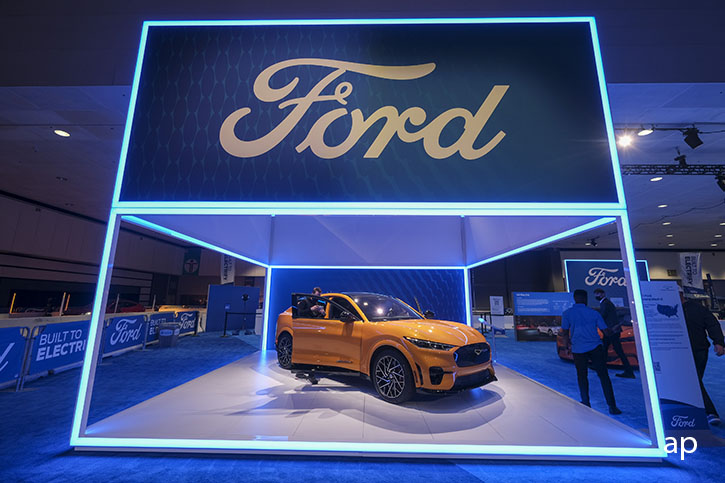
Most investors in electric vehicle makers turn their sights to Tesla (TSLA), the industry leader. Or maybe they take a flier on newer entrants, Lucid Motors (LCID) or Rivian (RIVN). Yet, if you're looking for the best opportunity in electric vehicles, you should be thinking of the granddaddy of auto makers: Ford (F). This might seem like heresy for Tesla fans but consider Consumer Reports just named Ford's Mustang Mach-E best electric vehicle of 2022. Take that Elon.
Ford's win toppled Tesla's Model 3 from its two-year-hold on the top spot and lifted the bar for electric vehicle standards across the industry. More than a century after revolutionising the automobile with its Model T “car for the masses” Ford is moving forward with an ambitious plan to reclaim its glory days by making electric versions of some of its most iconic brands.
As the Consumer Reports' accolade demonstrates, the strategy is gaining traction. “We're going to go all in to be a world-changing company once again,” president and chief executive Jim Farley told investors in early March as he laid out a sweeping change to Ford's corporate structure, splitting the company founded in 1903 into two distinct parts to maximize its potential.
For Farley, 59, an industry veteran, the mission to remake the company also has a personal connection: his grandfather began working at Ford's Model T plant in 1913 and imparted his love of cars to his grandson. If the plan succeeds, it could be world changing for investors, especially if the car maker achieves the lofty performance goals it has set for itself. “If they deliver, it implies a lot of upside to the stock,” says David Whiston, sector strategist at Morningstar. Whiston last month boosted his fair value estimate on Ford to $24 a share from $22 and raised his midcycle adjusted margin on earnings before interest and taxes, or EBIT, to 8% from7%.
Whiston’s revised estimate doesn’t fully reflect the company’s EBIT margin outlook of 10% by 2026, which it revised early last month from its prior forecast of 8%. Ford posted a 7% EBIT margin in 2021. Driving the gains, Farley predicts, will be higher volumes, lower prices for materials, and a $3 billion reduction in costs from its legacy internal combustion engine business, which will include layoffs.
Is Ford Stock Cheap?
At a recent price of $15.11 per share the stock represents a 38% discount to Whiston’s fair value estimate. While Ford’s shares continue to sport a 4-star Morningstar moderately undervalued rating, they are closing in on five-star territory and an undervalued classification at the $14.40 level.
The stock appears attractive by other measures, too. Ford’s forward price/earnings multiple of 7.85 times estimated 2023 earnings of $2.25 a share is well below the 12.50% earnings growth expected based on this year’s estimated earnings of $2.00 a share. That compares with a forward P/E of 18.22 times on the S&P 500. Ford posted net income of $1.59 a share in 2021.
Its $1.60 a share annual dividend yields 2.51%, compared with the 1.33% yield on the S&P 500. On a price-to-sales basis it trades at 0.49 times estimated 2022 sales of $157 billion.
How Many Electric Vehicles Will Ford Produce?
Ford expects annual global production of its electric vehicles to exceed two million by 2026, about one-third of its expected total volume, and up from an projected 600,000 in 2023. It also sees electric vehicles increasing to 50% of total volume by 2030, reflecting new products and market share gains. This year, it plans to invest $5 billion in electric vehicles, double the amount spent in 2021. Between now and 2026, Ford expects to spend $50 billion on EV and new technology development. Ford forecasts total company adjusted EBIT of $11.5 billion to $12.5 billion for 2022.
The carmaker, along with South Korea’s SK Innovation battery maker, is investing more than $11 billion in lithium-ion battery plants and electric-vehicle assembly plants in Tennessee and Kentucky and creating more than 11,000 jobs.
The company has a strong enough balance sheet reinvent itself: It reported more than $52 billion in cash and liquidity in the fourth quarter of 2021, which included its 12% stake in electric truck maker Rivian. Excluding Rivian, which is now trading at half its IPO price of $78 a share, Ford’s cash balance at year-end was $25.9 billion. Morningstar’s Whiston says it’s very likely Ford will unload its Rivian stake this year after the IPO lockup expires.
For all the excitement surrounding Ford, the stock has fallen sharply year to date. Supply chain disruptions caused by the Covid-19 pandemic and worsened by Russia’s invasion of Ukraine, rising costs of raw materials, and scepticism around its ability to execute its plan have created an opportunity in Ford stock for value-minded investors. Indeed, Ford paused production of the Mustang Mach-E this week at its Flat Rock plant in Michigan due to the chip shortage.
It also reported a 25.6% year-over-year decline in total sales in March, which discouraged investors but was not unexpected given that the chip shortage didn’t start to hurt U.S. car makers until June 2021, says Whiston. He expects sales to remain weak through the second quarter before production begins to more meaningfully increase in the second half. More encouraging, retail orders in March of 88,000 set a record and were up 66,000 from the year ago.
The pent-up demand for vehicles and the pricing power that automakers hold are reasons to be bullish.
What Does the New Ford Look Like?
The “new” Ford will have two distinct but dependent parts: Ford Model e, will represent “next century” innovative electric vehicle designs and be led by risk-taking entrepreneurial types more commonly found at tech startups, backed by the engineering and manufacturing scale and resources of the 118-year-old Fortune 500 company.
The other segment will be known as Ford Blue and will build on the company’s legacy internal combustion engine performance brands, including the iconic F-series, Ranger, and Maverick trucks, the Bronco and Explorer sport utility vehicles, and the Mustang. Like the Mustang Mach-E, others in its current fully electric lineup are based on existing best-selling Ford Blue models: the F-150 Lightning pickup truck and the E-Transit van, for instance. Ford Blue is seen as the cash cow that helps fund the start up. Farley maintains the split isn’t a precursor to a spinoff and stresses the complementary nature of both businesses.
“Each will drive on the chemistry of the other to create an even stronger and more resilient Ford,” Farley told investors. “For example, the embedded software, digital experience inside the vehicle will be developed by Model e and that will benefit all customers. And Ford Blue's industrial power will help Ford Model e scale up to reach millions of EV customers.”
What Is Driving Ford's Growth?
The combination of a fortress balance sheet, engineering prowess, great brands, and ability to scale up is what sets Ford apart from its competitors.
The two business segments will also underpin its efforts at improving the Lincoln luxury brand segment, leveraging its Ford Pro business that caters to commercial and government customers by providing financing, servicing, and support, and assisting its Ford Drive mobility segment focused on autonomous vehicles through its 41% investment stake in Argo AI and joint venture with Volkswagen, with which it is also collaborating on electric vehicles for the European market.
The company’s restructuring began in 2018 under former chief executive Jim Hackett, but Farley has moved the process into overdrive and shifted the focus to electric vehicles. He took the helm of the company in October 2020 after serving in a variety of roles, including chief executive and chairman of Ford Europe, president of Global Markets, and president of New Business, Technology, and Strategy.
Ford scion and executive chairman Bill Ford Jr. and former chief executive Alan Mulally, who steered the company through the Great Recession, lured Farley away from Toyota in 2007 where he headed sales and marketing for its luxury Lexus brand. In September, Farley tapped Doug Field, a veteran of Apple and Tesla in design and engineering, to lead the push into electric vehicles. And he has said he will spend to recruit top tech talent to achieve the aim of making Ford the number one electric vehicle producer in the world.










:quality(80)/cloudfront-us-east-1.images.arcpublishing.com/morningstar/347BSP2KJNBCLKVD7DGXSFLDLU.jpg)


















